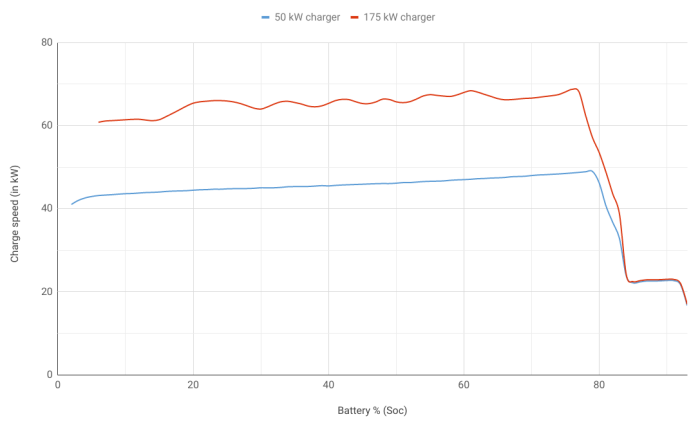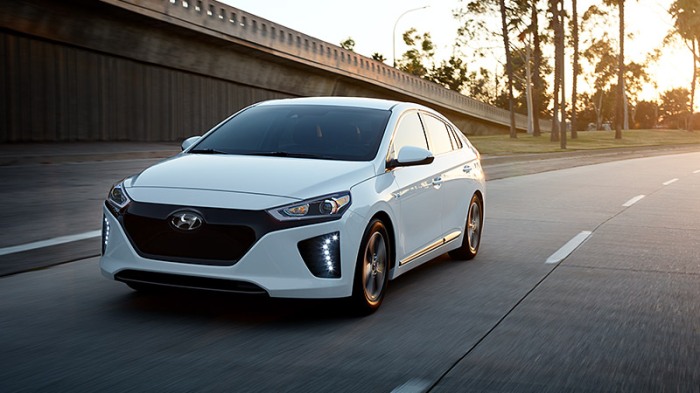The Claim
The Hyundai Ioniq Electric can charge “at up to 100 kW” on a DC charger sort of like a Tesla can do at a Supercharger.
The Facts
There appears to be no evidence that this is true or that Hyundai ever actually meant to say that the Ioniq would do that.
Standard disclaimer: this is an Auto Correction article. Topics are chosen not to point out a mistake in a specific article but rather to discuss a recurring point of confusion in media coverage or among EV enthusiasts. Getting all of the details correct in every article is very difficult (if not impossible), especially on a deadline.
Discussion
This 100 kW claim has been reported by multiple news sites over the last couple of years since Hyundai revealed the car at the Geneva and New York auto shows in 2016.
Examples:
An article back in 2016…
“When the time comes to charge, the Ioniq offers the usual support for 6.6-kW 240V home chargers as well as DC fast charging at up to 100-kW. While that’s a bit less than the 120-kW offered by Tesla Superchargers, it’s still double the 50-kW available with most other current EVs. Now you just need to find a 100-kW charger.” — Forbes
When discussing charging in an Ioniq Electric review article…
“The Ioniq can be charged at up [to] 100 kW…” — Extreme Tech
Charging provider ChargePoint’s blog makes the claim…
“Ioniq Electric has DC fast charging available with an SAE Combo connector and can charge up to 100 kW, faster than other models on the market. — ChargePoint blog
From articles as recent as February, 2018…
“Hyundai says its Hyundai Ioniq Electric is currently the only vehicle available in North America that can charge at 100 kW on some of the top Combined Charging System (CCS) hardware that’s rated to 100 kW or more.” — Car and Driver
There seems to be no evidence that Hyundai itself has said the car can charge at up to 100 kW. Rather, the company has given estimated charging times using phrasing like “when connected to a 100 kW charger”.
Hyundai’s recent marketing materials say it can charge from 0-80 percent in 23-24 minutes. The battery appears to have a usable energy capacity of about 28 kWh. If you take 80 percent of that it is about 22 kWh of energy that needs to be fast charged into the battery. Doing that in 24 minutes takes an average power rate of 56 kW.
It’s a bit challenging to find actual DC chargers for testing. Almost all publicly available units today are limited to 125A which limits charging to under 50 kW. This will change later this year but right now there are just a few chargers in Europe that are up to the task. Fortunately, a few videos of charging an Ioniq Electric at more powerful chargers in Europe have now been posted online.
The charger used in a Norwegian test by Bjorn Nyland is said to be capable of up to 120 kW overall according to the website of the charging provider, Arctic Roads, that installed it. However, a brochure on that apparent charger hardware from its manufacturer says that a single CCS plug is limited to 200A (100 kW).
The video appears to show the Ioniq charging at a rate of about 60-70 kW from near empty to near 80 percent full. Although not shown, the implied charging current appears to be around 175-185 amps which is a bit less than the inherent limits of the DC charger itself.
Just recently on April 4, GreenCarReports quoted Hyundai as saying at the New York Auto Show that the Ioniq Electric can charge at up to 173A or 70 kW although it still confusingly reported “that translated to a rate of 70 kilowatts—for which a 100-kw charging output was required.”
The most recent actual charging test came from Fastned, a European charging provider, in March. They tested an Ioniq Electric on an ABB charger capable of putting out 375A and reported that, again, the Ioniq drew about 60 to 70 kW while charging.

This graph from the Dutch charging provider Fastned shows the Ioniq Electric charging on a single cabinet ABB Terra HP charger capable of putting out about twice as much power as the car actually requests.
Categories: Auto Correction

Your “Auto Correction” feature provides a great service in pulling together conflicting reports of technical specs from various sources and holding them up to the light of engineering truth. I saw that Fasned graph, too. I had always assumed there was something really off with the 100 kW charging, but I’m impressed with the ability of the Ioniq to do up to 70 kW all the way to 80%. And that chart has the ring of truth. I’m very curious about how a battery that small is handling that kind of C-rate for that long without frying the cells.
I can’t find any description or illustration that would give us a lead on the internal battery architecture. From the illustrations of the completed pack, it isn’t skateboard style. The cells likely stand pretty tall. A bottom-plate type TMS with that small of a bottom plate footprint couldn’t maintain cell temperatures anywhere near 45 C. It would almost take something with as much active surface area per-kWh as the Chevy Volt’s and Spark EV’s (using LG cells) active-inter-cell-plate cooling system. That is why the Spark EV was able to have such a fast DCFC rate for such a small battery.
LikeLiked by 1 person
Perhaps surprisingly, the Ioniq Electric cells are only air-cooled by a fan pushing through cabin air (but with a dedicated electric air heater for winter conditions).
LikeLike
It’s an old topic. Yet to be resolved. – http://www.mykiasoulev.com/forum/viewtopic.php?f=14&t=685&hilit=arctic+roads&start=50#p7890
LikeLike
It has been resolved.
The most recent charging test mentioned near the bottom of the article, from Fastned, was on a “175 kW” ABB charger capable of 375 amps. That is far more than the “100 kW” 200 amp charger in Vestby, Norway that Bjorn Nyland used in his video.
All these charging tests on the Ioniq Electric has shown similar results. We can definitely now say that the 60 to 70 kW charging rate is not being limited by the charging equipment — it is a limitation of the car.
The only real question at this point is whether there could be a temperature limitation. Colder batteries have to be charged slower in order to avoid problems on the graphite anode.
We can see what later charging reports say when warmer weather arrives.
LikeLike
–
I am happy that fastned is providing these fast chargers. Am looking forward to seeing the data from a car that can actually take more than 200A. This will finally settle the dispute.
From the Fastned twitter feed.
Hyundai Ioniq – 70 kW Hyundai Kona – 100 kW Jaguar I-Pace – 100 kW Audi Q6 e-tron – 150 kW
LikeLiked by 1 person
You said:
“This will finally settle the dispute.”
Can you tell me more about the specific “dispute” that you are interested in settling? I am unsure exactly what your meaning is.
Thanks for commenting on the story!
LikeLike
This battery pack doesn’t have liquid thermo management? Until they do, Hyundai maybe better off just using LG Chem’s battery pack (like GM’s Chevy Bolt).
LikeLike
It will be interesting to see how well the Ioniq pack holds up. It contains cells from LG but they seem to be different from LG cells used in the Bolt or Volt
I plan to have another story or two about the Ioniq Electric in the near future.
LikeLike